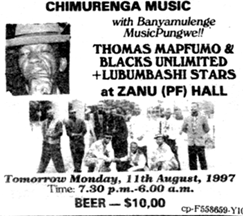 The continuing popularity of Mapfumo's Chimurenga music in Zimbabawe: an advertisement for Mapfumo's concert during the 1997 Hero's Day celebrations. Click for another example. [Added by GPL.]
The continuing popularity of Mapfumo's Chimurenga music in Zimbabawe: an advertisement for Mapfumo's concert during the 1997 Hero's Day celebrations. Click for another example. [Added by GPL.]By 1945 a state based on the suppression of democratic rights and the domination of Africans by means of brutal laws and semi-military force had been established. . . . Right from the beginning the people resisted this new order and protested against it, as the first and second Chimurenga of 1893 and 1896-7 testifies. However, after their defeat in these uprisings, they were methodically marginalised into subordination and their voices silenced. Formal means of representation such as the parliament and the media, by design, did not create space for the blacks to voice their discontent with the system. For example, as a result of the Electoral Act of 1969, 6,5 million blacks were represented by only 16 members of Parliamentwhile 278 000 whites elected 50 members to the house, which meant little or no representation of the blacks (Auret 1992: 75). Other channels of representation such as media remained centralised in the urban areas, and were mainly in English which many blacks were not vety familiar with. All the media discussing important laws and issues were in the white man's language, which meant little or no participation by the majority. As such the settlers secured a hegemonic structure by systematically silencing the blacks into subordination.
 The continuing popularity of Mapfumo's Chimurenga music in Zimbabawe: an advertisement for Mapfumo's concert during the 1997 Hero's Day celebrations. Click for another example. [Added by GPL.]
The continuing popularity of Mapfumo's Chimurenga music in Zimbabawe: an advertisement for Mapfumo's concert during the 1997 Hero's Day celebrations. Click for another example. [Added by GPL.]
Where formal means of representation were closed to the people, their songs provided an outlet for their anguish and bitterness about the system. Their resistance to colonial rule became covert rather than overt. There emerged a new artistic genre that was preoccupied with articulating the people's experiences under the new system, partly as a way to cope with the new challenge and also as a way to express their protest against it. These injustices and the conflict they created, mothered a new genre of political protest music which crystallised in the mid 1960s after the Unilateral Declaration of Independence (UDI). This marked the birth of a music which came to be known as Chimurenga music, after the Shona and Ndebele uprisings of 1893 and 1896, which had come to be known as the first Chimurenga. According to oral tradition the tag Chimurenga was coined after a great Shona traditional warrior and legendary hero, Sororenzou Murenga who was renowned for his fighting prowess. Great fighters after him were therefore believed to be possessed by his spirit. Thus they were believed to be fighting Chimurenga, which when translated means "fighting the Murenga style". Hence the liberation struggle of the late 1960s came to be the second Chimurenga, and the genre of music that emerged from this spirit of struggle naturally acquired this name tag, and according to Pongweni (1982), won the liberation war. Chimurenga music was therefore a music that emerged from the tensions and conflict between the African people and the white colonial system.
[From Alice Dadirai Kwaramba, The Battle of the Mind: International New Media Elements of the New Religious Political Right in Zimbabwe. Oslo:University of Oslo, 1997, page 5. Available from Department of Media and Communications [[email protected]].